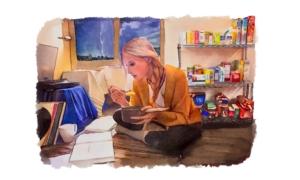Every year, across the world, millions of drivers experience vehicular breakdowns. Finding yourself on the side of the road can be frustrating, scary, and even dangerous.
Thankfully, there are several things you can do to increase safety and shorten the amount of time it takes to get help.
“It’s important to remember that the supplies you carry in your vehicle might not just be of use to you, but might also allow you to help others,” Dave, a retired EMT and fireman, told The Epoch Times.
1. Contact List
Keep a paper list of numbers you may need to call during emergencies, including AAA details (roadside assistance and member number) and phone numbers of family and friends. It can be difficult to recall numbers under stress, and if something happens to your phone, having a backup that’s quickly accessible can be helpful.2. Money
Credit cards are great, but they require intact electrical and communications systems. Keeping a reasonable stash of money hidden in your vehicle just for emergencies can give you purchasing power when credit cards can’t be used.3. Water
That half-empty bottle of water you just brought into the car can run out faster than you think, especially in hot weather. Keep at least a few bottles of water in your vehicle at all times for emergencies. Extra water is important for you and your passengers.4. Snacks
A few packages of crackers, cookies, or trail mix are good to have on hand in case of an emergency. While these aren’t survival rations, they can provide quick energy and stave off hunger if you have to wait a while for help.5. Spare Glasses
If you wear glasses, it’s possible that the pair you’re wearing can get lost or broken. Keeping extra glasses in your car will help you avoid visual difficulties, especially at night.6. First-Aid Kit
A small first-aid kit can help you quickly and efficiently deal with minor cuts, scrapes, headaches, allergies, and nausea.7. Paper Goods
Paper towels, toilet paper, wet wipes, and tissues can all be helpful in an emergency.8. Fire Extinguisher
“I can’t recall the number of times a small fire was able to progress into a major one simply because nobody had a fire extinguisher,” Dave said. Even a small fire extinguisher can help extinguish initial fires.9. Adequate Fuel
A surprising amount of individuals operate their vehicles with very little fuel. It’s best to keep your fuel tank at least half full at all times in case of unexpected delays or detours.10. Signaling Devices
If you break down on the side of the road, be sure to activate your emergency flashers immediately. This allows other drivers to see you, which is especially important on roads with higher speed limits and heavier traffic.Road flares can augment emergency flashers to help drivers see you earlier, especially at night.
- Chemical road flares: These burn with a bright, red flame and can be stored for decades with no loss in performance. They do require some degree of knowledge to ignite and place and usually last no more than 30 minutes before burning out. They can also be a fire hazard around dry grass or foliage.
- Electronic road flares: These battery-powered road flares are designed to mimic the visibility of their chemical counterparts. They store well, don’t present a fire hazard, can shine continuously or flash, and don’t need special knowledge to use. However, their batteries must be replaced periodically to ensure they’re still strong.
Alternatively, you can use reflective triangles, which passively reflect light and don’t burn or need batteries. They don’t have the warning range of road flares but can still provide protection.
11. Weather Gear
Having some weather gear on hand can be a lifesaver in bad weather. Dave recommends a good umbrella, a disposable rain poncho, and a hat that can shield your face and neck.A compact, folding umbrella is preferable to the longer, fixed versions.
While an umbrella is good in lighter rain, a poncho is better for high winds or heavy downpours when an umbrella can get pulled out of your hand.
12. USB Rechargeable Flashlight
Breaking down at night, especially when the car’s power goes out, can leave you in total darkness.Phone flashlights can work for this purpose but can quickly drain your phone’s battery. Keychain lights work well enough but generally don’t have much power, and batteries can drain quickly.
Keeping an emergency flashlight in the car can save the day. A rechargeable flashlight that uses the same USB cable that your phone uses is a smart idea.
13. Emergency Blanket
A good blanket can come to the rescue in cold weather, especially if you tend to dress lightly and rely on the car’s heater to keep you warm.14. Portable Power Bank
It’s essential to keep a phone charging cable in your car and to keep your phone’s battery topped off.However, if your car battery becomes disabled, you may be unable to charge your cellphone with the cable. Having an external battery charger can allow you to maintain communication.
15. Reflective Safety Vest
Also humorously referred to as “don’t hit me” vests, reflective vests usually come in bright yellow or orange and have thin stripes on the front and back that reflect headlights and flashlights. Put one on immediately if you need to get out of your car after a breakdown. This will help other drivers see you and keep you as safe as possible, especially in dark environments. It also informs those passing by that you have a problem, potentially causing them to call for or provide assistance.16. Utility Items
The following utility items can be helpful in an emergency:- Duct tape: “Never underestimate the ability of duct tape to fix nearly anything—for a while,” Dave said.
- Multitool: This is a small tool with a range of functions, including pliers, a knife, screwdrivers, and scissors.
- Jumper cables: These will allow you to start your car or help others when a car battery is drained.
17. Backpack or Gym Bag
A backpack or gym bag can store most or all of these emergency items in a single, tidy location. Choosing a brightly colored backpack or gym bag can help you spot your supplies immediately.Keep in mind that the items on this list aren’t intended for survival scenarios but are designed to assist you or help others in the event of a roadside breakdown.







